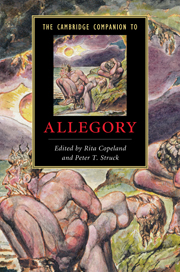Book contents
- Frontmatter
- Introduction
- Part I: Ancient foundations
- Part II: Philosophy, theology, and poetry 200 to 1200
- 4 Allegory and ascent in Neoplatonism
- 5 Allegory in Christian late antiquity
- 6 Allegory in Islamic literatures
- 7 Twelfth-century allegory: philosophy and imagination
- Part III: Literary allegory: philosophy and figuration
- Part IV: The fall and rise of allegory
- Further reading
- Index
4 - Allegory and ascent in Neoplatonism
from Part II: - Philosophy, theology, and poetry 200 to 1200
Published online by Cambridge University Press: 28 January 2011
- Frontmatter
- Introduction
- Part I: Ancient foundations
- Part II: Philosophy, theology, and poetry 200 to 1200
- 4 Allegory and ascent in Neoplatonism
- 5 Allegory in Christian late antiquity
- 6 Allegory in Islamic literatures
- 7 Twelfth-century allegory: philosophy and imagination
- Part III: Literary allegory: philosophy and figuration
- Part IV: The fall and rise of allegory
- Further reading
- Index
Summary
In Late Antiquity a series of ideas emerges that adds a kind of buoyancy to allegorism. Readers' impulses toward other regions of knowledge begin to flow more consistently upward, drawn by various metaphysical currents that guide and support them. A whole manner of Platonist-inspired architectures structure the cosmos in the early centuries of the Common Era, among thinkers as diverse as the well-known Origen and the mysterious Numenius. Plato's understanding of appearances had always insisted on some higher, unfallen level of reality, in which the forms dwell, and to which we have no access through our senses. This other level seems to invite allegorical aspirations. Of course, Plato himself prominently declined the invitation, and it is no small irony that his work should have become the font of such heady visions. He consistently disparages poetry's claims to any kind of truth, let alone the grandiose varieties that allegorical readers tend to ascribe to it. The distance between the sensible world and the real source of truth operates for him as a chastening agent, a message of epistemological caution echoing over a chasm. (Plato typically leaves the task of mediating it to the colorless verb metecho ”participate.”) But his later followers do not feel such stringent compunctions. They will embrace Plato's metaphysics of fallenness, but then shift their emphasis from the distance that separates us and the highest truths to the notion that the world here and now is (somehow) connected to a higher order - a position inarguably Platonic but rarely more than implicit in the master's work.
- Type
- Chapter
- Information
- The Cambridge Companion to Allegory , pp. 57 - 70Publisher: Cambridge University PressPrint publication year: 2010
- 9
- Cited by



